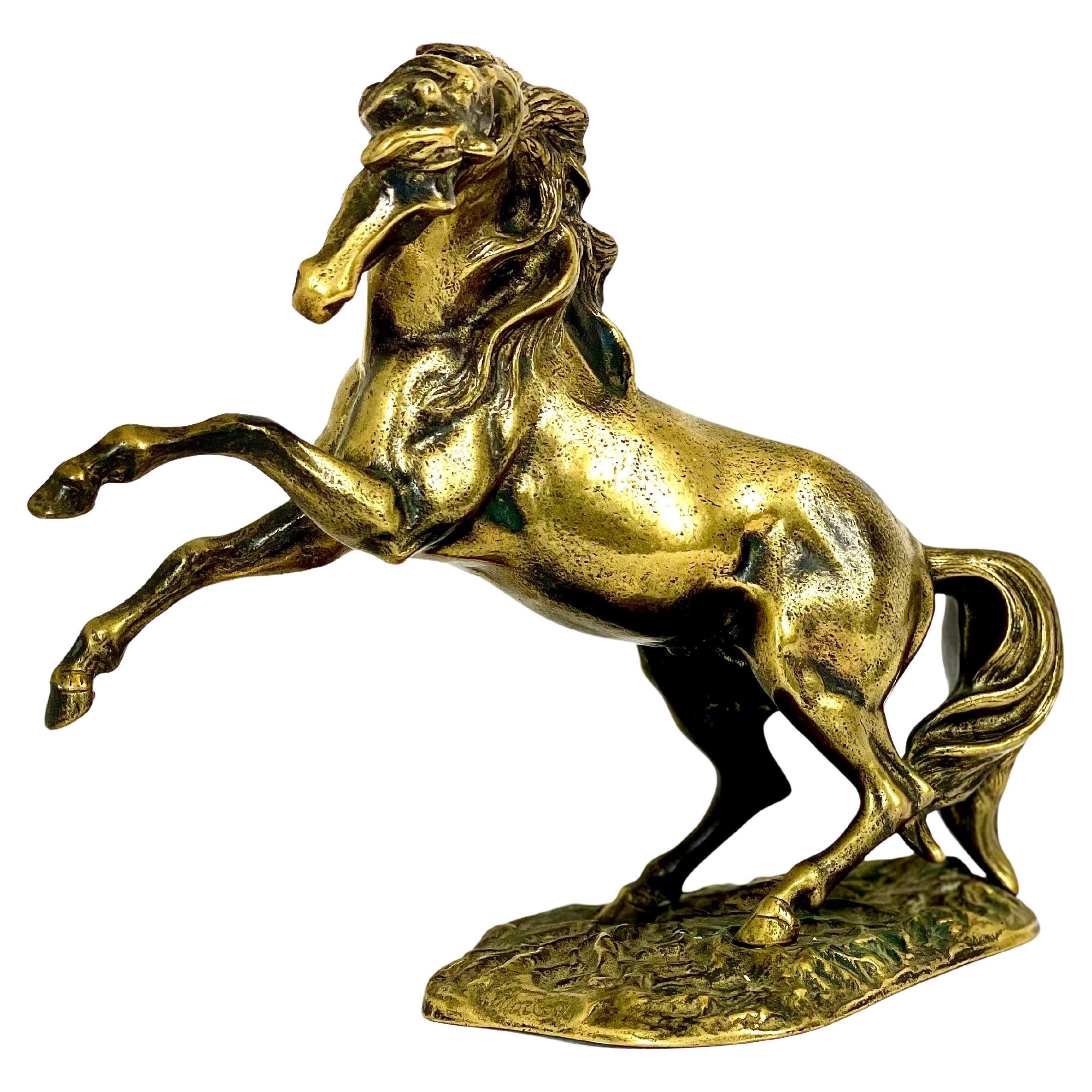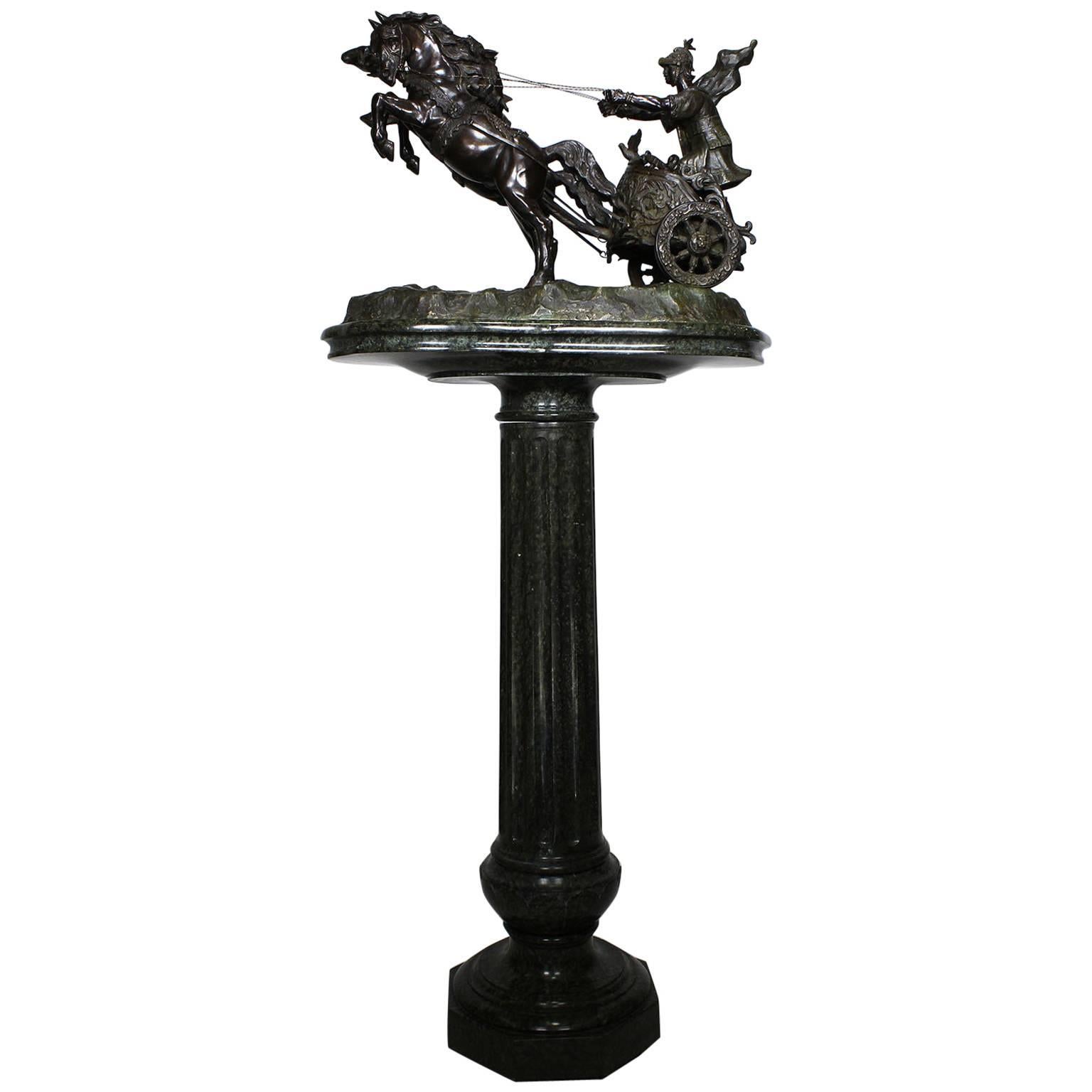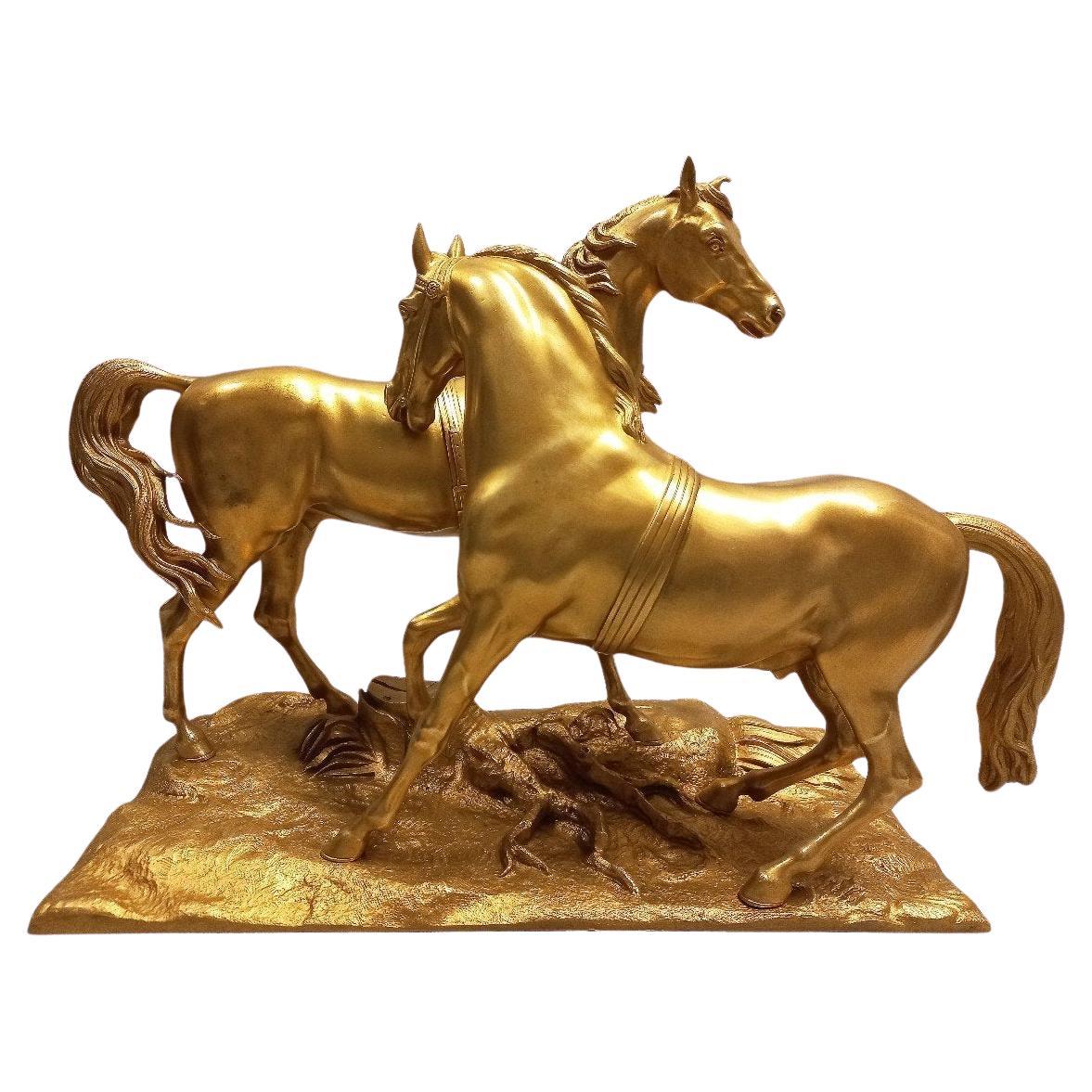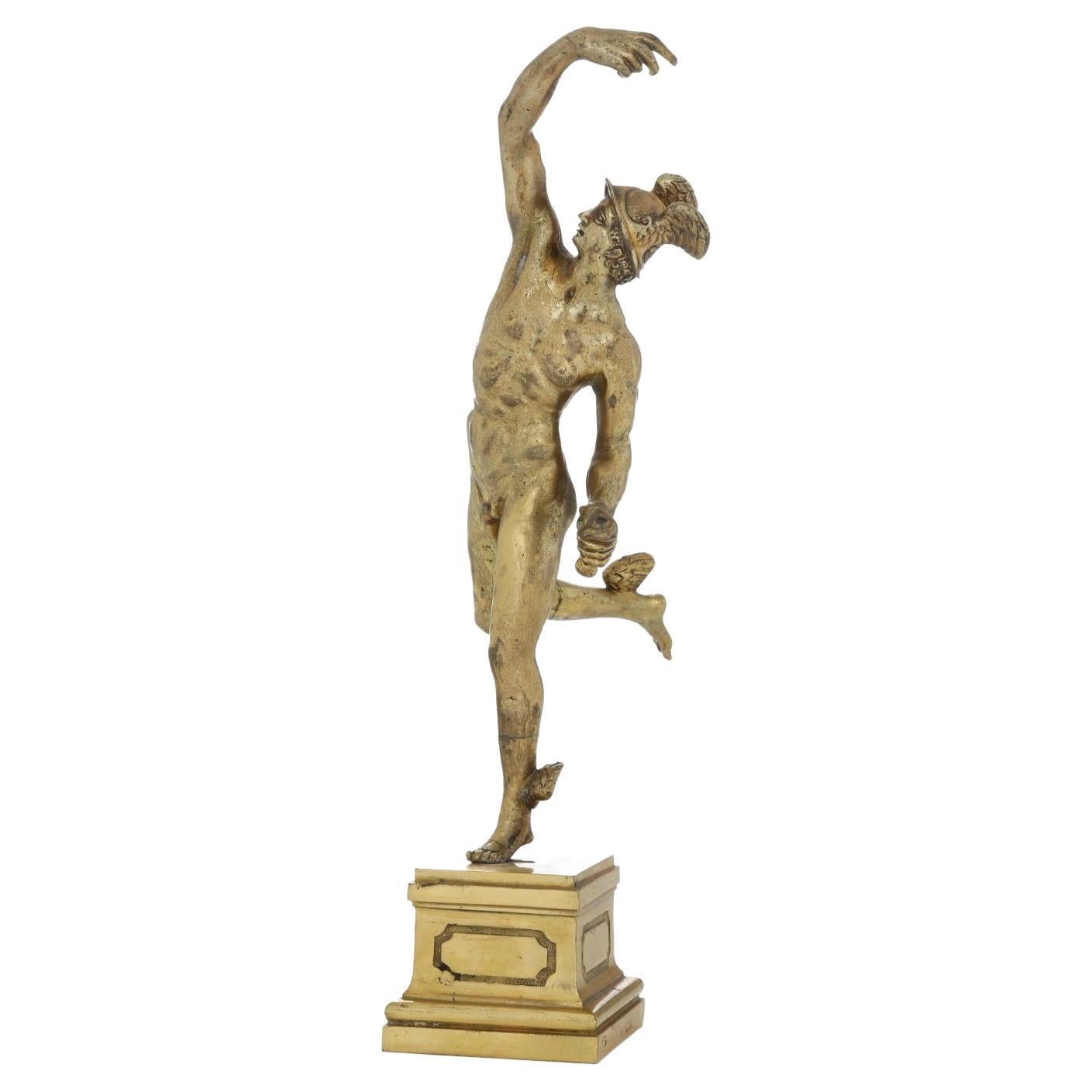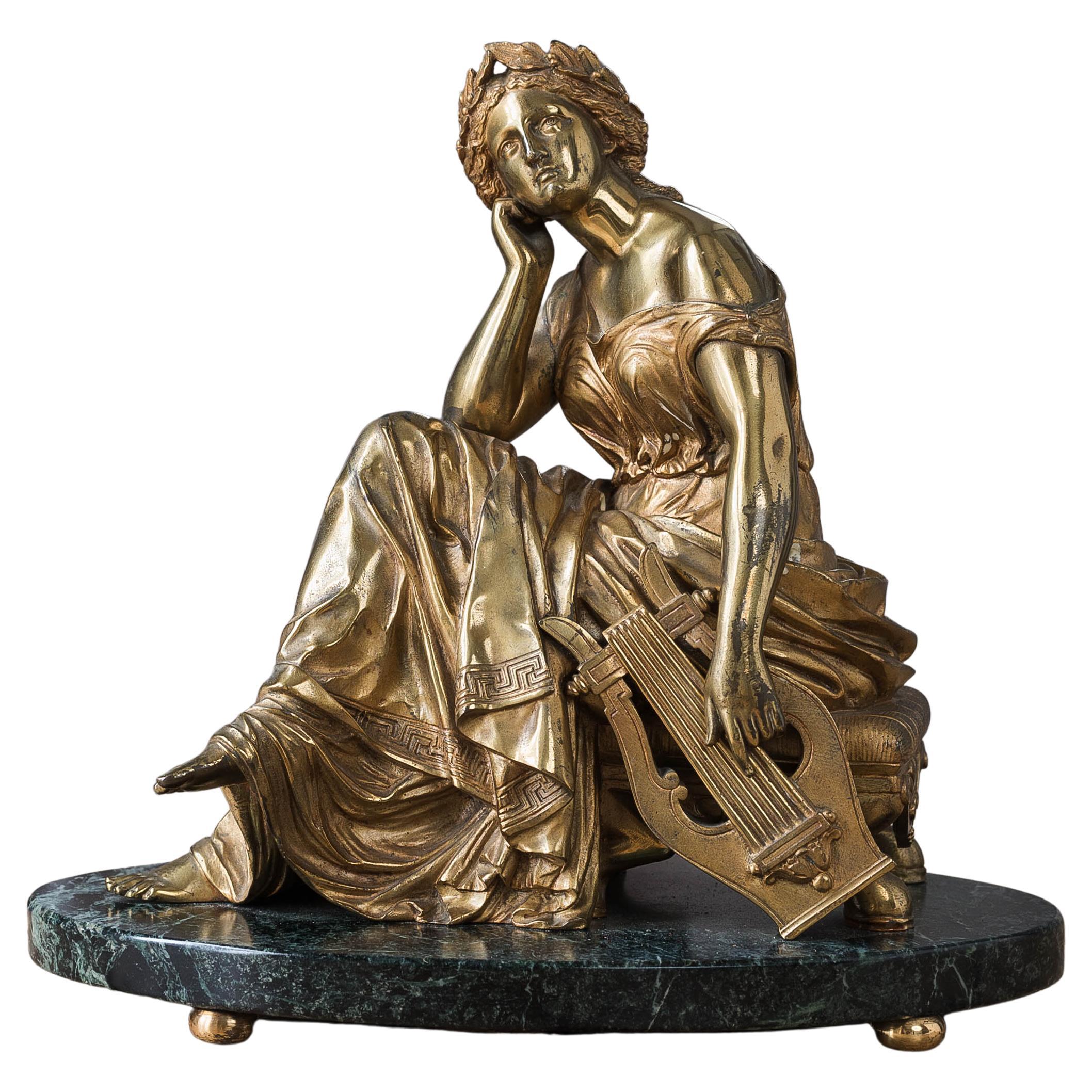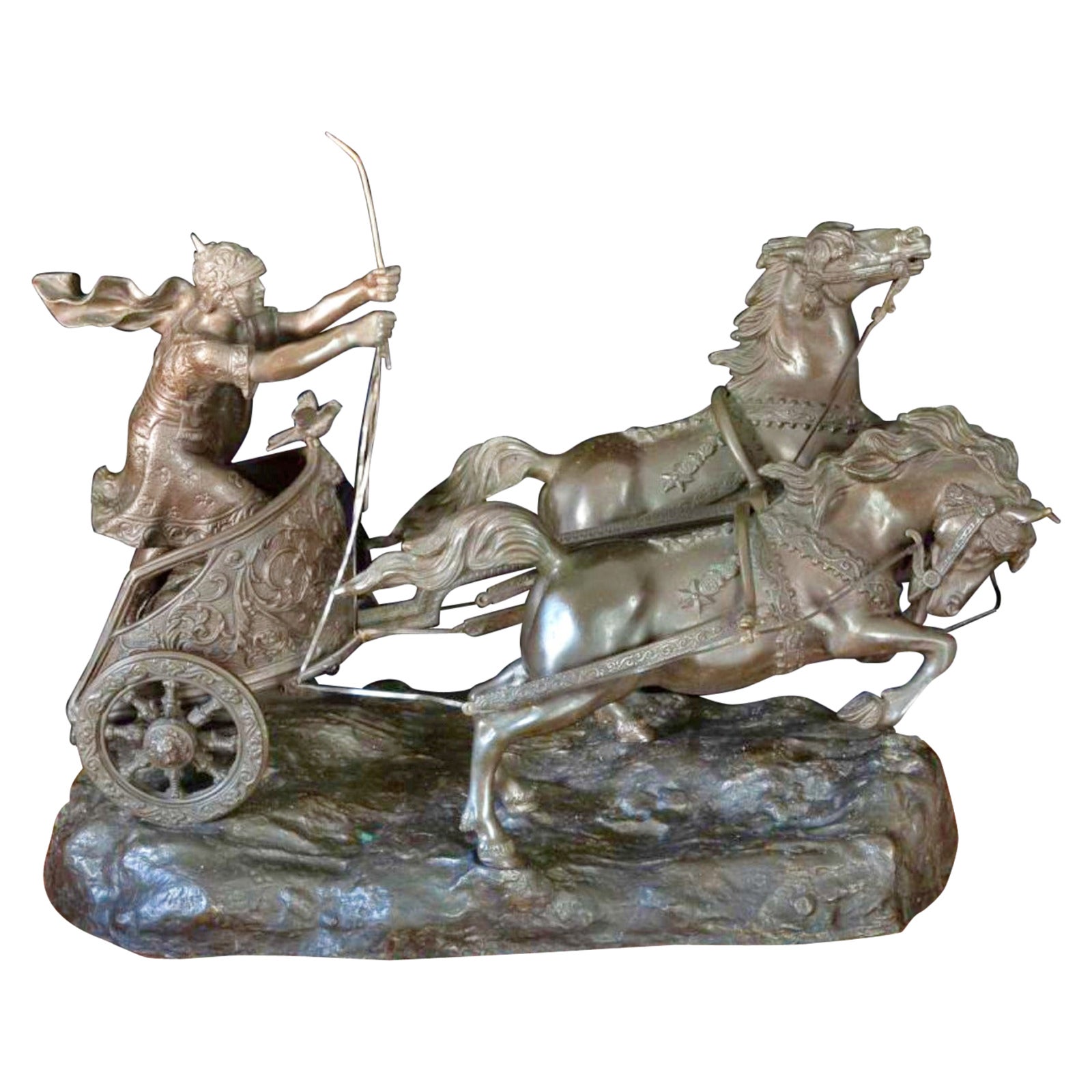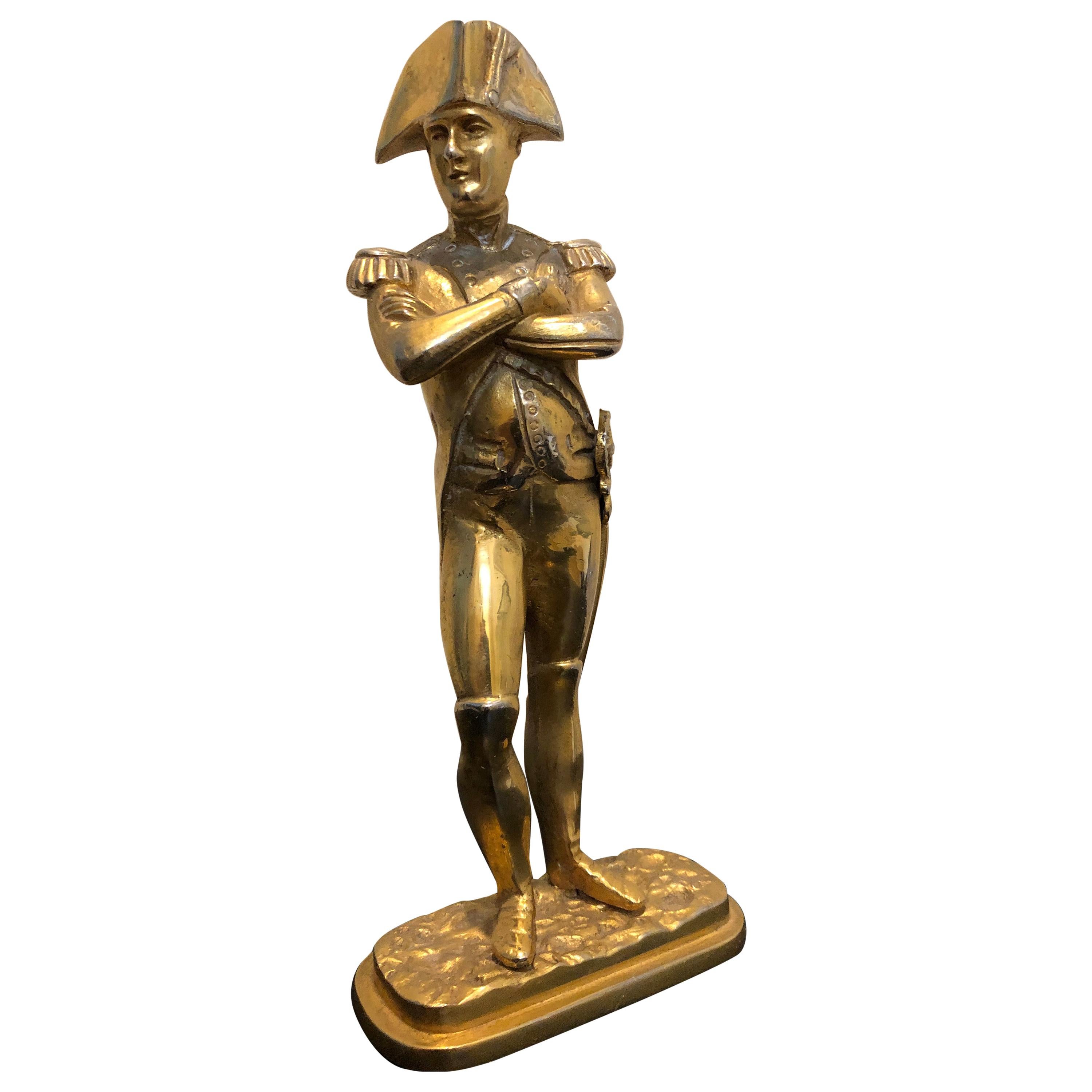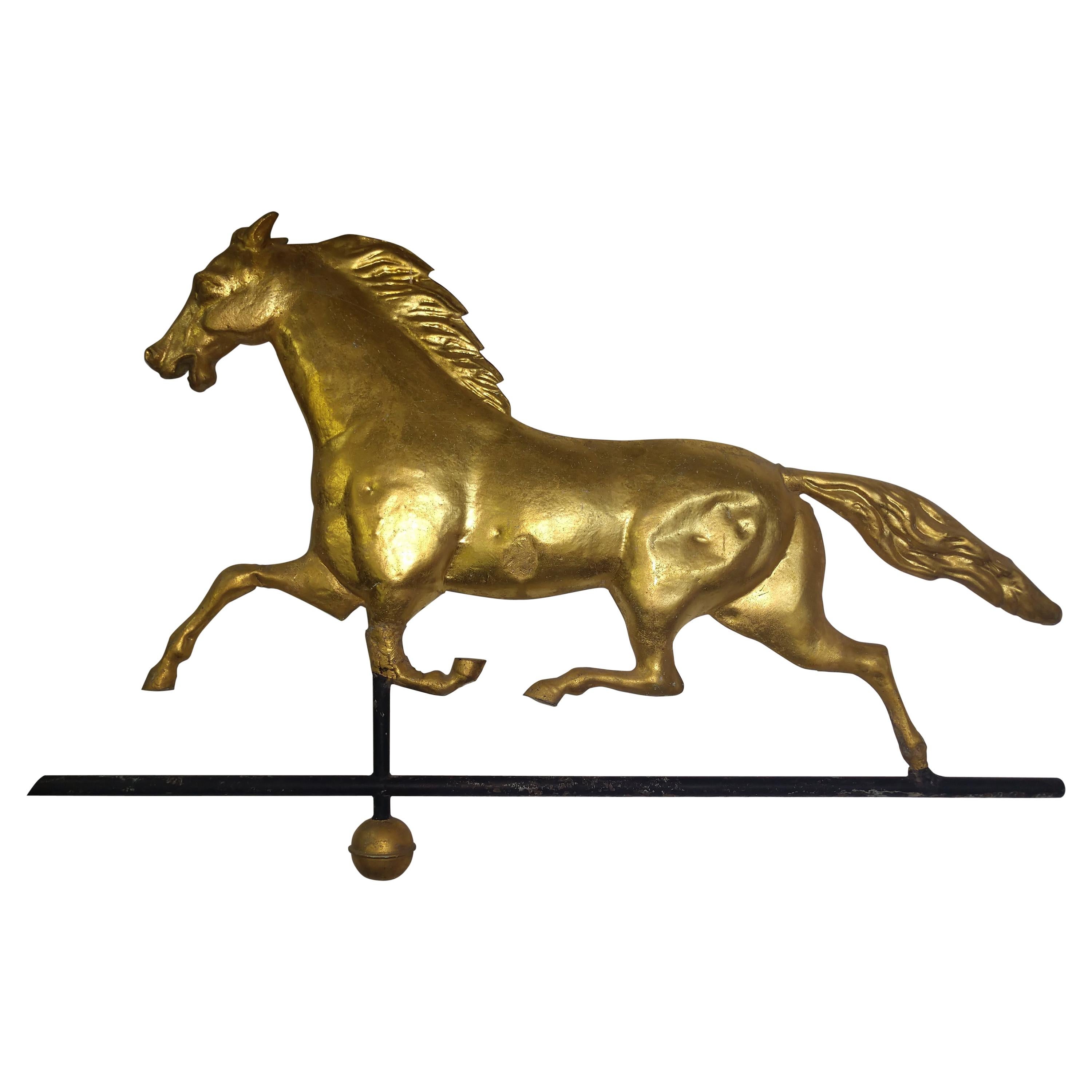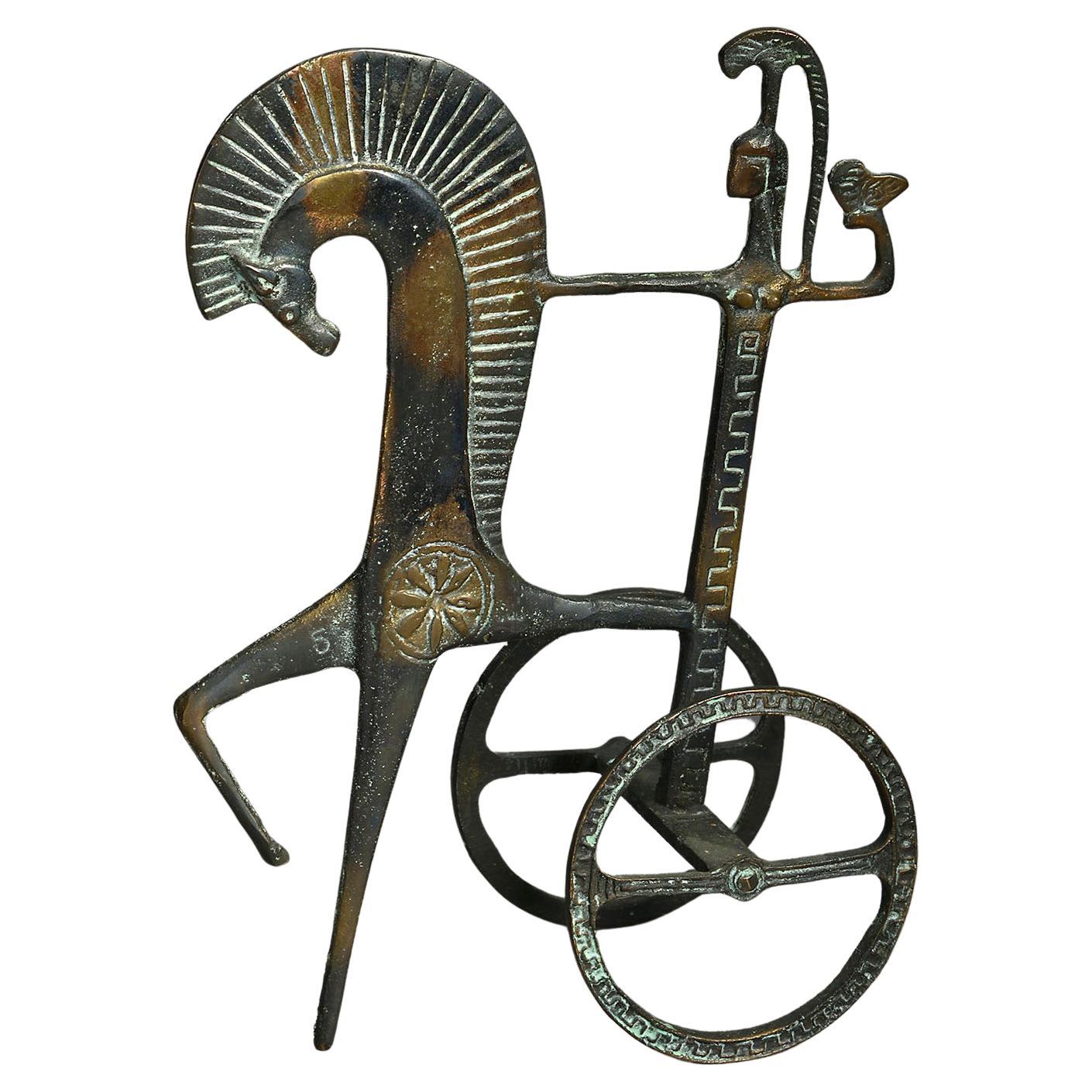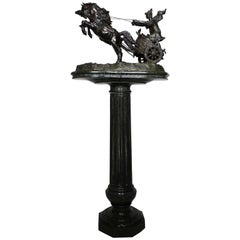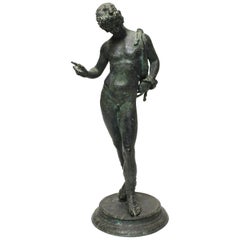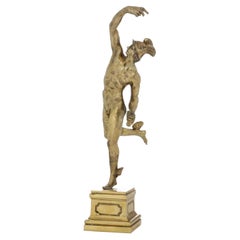
Luigi Belli - Italian 19th Century Gilt Bronze Quadriga Chariot with horses
View Similar Items
Want more images or videos?
Request additional images or videos from the seller
1 of 11
Luigi Belli - Italian 19th Century Gilt Bronze Quadriga Chariot with horses
About the Item
- Attributed to:Luigi Belli (Sculptor)
- Dimensions:Height: 21.5 in (54.61 cm)Width: 38.5 in (97.79 cm)Depth: 21 in (53.34 cm)
- Style:Greco Roman (In the Style Of)
- Materials and Techniques:
- Place of Origin:
- Period:
- Date of Manufacture:circa 1870-1880
- Condition:Wear consistent with age and use. Minor fading. Overall condition is very good with minor wear and rubbing consistent with age, use and handling. A very impressive bronze group.
- Seller Location:Los Angeles, CA
- Reference Number:Seller: Ref.: A11211stDibs: LU179624140263
About the Seller
5.0
Vetted Seller
These experienced sellers undergo a comprehensive evaluation by our team of in-house experts.
Established in 1982
1stDibs seller since 2016
114 sales on 1stDibs
More From This SellerView All
- Italian 19th Century Bronze Sculpture Group of a Two-Horse Roman Chariot & RiderLocated in Los Angeles, CAA fine and large Italian 19th century Greco Roman style brown patinated bronze sculpture group of a two-horse Roman Chariot and rider in a dark patina, raised on a fitted Verde d'alp...Category
Antique 19th Century Italian Greco Roman Figurative Sculptures
MaterialsMarble, Bronze
$9,850 Sale Price41% Off - Pair French 19th/20th Century Gilt-Bronze Sculptures of The Marly Horses LampsBy Guillaume CoustouLocated in Los Angeles, CAA Fine Pair of French 19th/20th Century Gilt-Bronze Sculptures of "The Marly Horses" (Now turned into lamps) After the original by Guillaume Coustou (French, 1677-1746). The large pair of equestrian bronze sculptures, finished in a gold patina, each depicting rearing horses with their groom, both raised on oval a black slate and Bardiglio marble bases and fitted with modern electrical twin-light brass fittings and cream colored shades. The base on an ebonized wooden platform. Circa: Paris, 1900-1920. Sculpture & Base Height: 31 1/4 inches (79.8 cm) Base Width: 21 3/4 inches (55.3 cm) Base Depth: 12 3/4 inches (32.4 cm) Height to top of (Adjustable) shade fitting: 48 1/4 inches (122.6 cm) Shade Height: 15 inches (38.1 cm) Shade Width: 26 inches (66.1 cm) Shade Depth: 20 inches (50.8 cm) The original Marly Horses are two 1743–1745 Carrara marble sculpted groups by Guillaume Coustou. They were commissioned by Louis XV of France for the trough at the entrance to the grounds of his château de Marly. Coustou's last works, they were intended to replace two other sculpted groups, Mercury on Pegasus and Pegasus, Renown of Horses, both by Antoine Coysevox, which had been removed to the Tuileries Gardens in 1719. Louis XV chose the modellos in 1743 and the full-size sculptures were completed in only two years, being installed at Marly in 1745. They proved highly successful in reproduction, particularly on a smaller scale, and prefigured Théodore Géricault and other Romantic artists' obsession with equestrian subjects. The Marly horses were later also used as the central motif of the monochrome 819-line RTF/ORTF test card which was used on TF1 from 1953 until 1983. The originals were moved to the place de la Concorde in Paris in 1794 and Louis-Denis Caillouette (1790–1868) restored them in 1840. In 1984 it was concluded that the annual military parades on 14 July were damaging the sculptures and they were replaced by marble copies produced by Michel Bourbon in the studio of a subsidiary of Bouygues. The latter also gained the right to an extra copy, which was placed in Bouygues's social building. The original sculptures were moved to a former courtyard in the Richelieu wing of the Louvre Museum, which was renamed the 'cour Marly' in their honour, whilst Bourbon's two main copies were moved to the originals' first site near the trough at Marly, with work overseen by the architect Serge Macel. Guillaume Coustou the Elder (29 November 1677, Lyon – 22 February 1746, Paris) was a French sculptor of the Baroque and Louis XIV style. He was a royal sculptor for Louis XIV and Louis XV and became Director of the Royal Academy of Painting and Sculpture in 1735. He is best known for his monumental statues of horses made for the Chateau of Marly, whose replicas now stand in the Place de la Concorde in Paris. Coustou was a member of a family of famous sculptors; his uncle, Antoine Coysevox, was a royal sculptor; his elder brother, Nicolas Coustou was a sculptor, and his son Guillaume Coustou the Younger also become a noted royal sculptor. Like his older brother, he won the (Prix de Rome) of the Royal Academy which entitled him to study for four years at the French Academy in Rome. However, he refused to accept the discipline of the academy, gave up his studies, set out to make his own career as an artist. He worked for a time in the atelier of the painter Pierre Legros, and eventually returned to Paris. Upon his return to Paris, he assisted his uncle Coysevox in making two monumental equestrian sculptures, Fame and Mercury, for the Château de Marly, the new residence of Louis XIV near the Palace of Versailles, where he went to escape the crowds and ceremony of the Palace. He later (1740–1745), made his own horses, The Horses of Marly, his most famous works, to replace them. The horses reinvent the theme of the colossal Roman marbles of the Horse Tamers in the Piazza Quirinale, Rome. They were commissioned by Louis XV in 1739 and installed in 1745 at the Abreuvoir ("Horse Trough") at Marly. The horses were considered masterpieces of the grace and expressiveness of the French Late Baroque or Rococo style. After the Revolution they were moved from Marly to the beginning of the Champs-Élysées on the Place de la Concorde. The originals were brought indoors for protection at the Louvre Museum in 1984. In 1704 Coustou was received into the Académie royale de peinture et de sculpture. The work he made to mark his entrance was Hercules on the Pyre, now in the Louvre. It displays the special hallmark of the Baroque, a twisting and rising transverse pose, as well as highly skillful carving. He rose to become Director of the academy in 1733. Another of his major works from his later career, the statue of Maria Leszczynska, (1731)is on display at the Louvre. Coustou also created two colossal monuments, The Ocean and the Mediterranean among other sculptures for the park at Marly; the bronze Rhone, which formed part of the statue of Louis XIV at Lyons, and the sculptures at the entrance of the Hôtel des Invalides. Of these latter, the bas-relief representing Louis XIV mounted and accompanied by Justice and Prudence was destroyed during the Revolution, but was restored in 1815 by Pierre Cartellier from Coustou's model; the bronze figures of Mars and Minerva (1733–34), on either side of the doorway, were not interfered with. In 1714 for Marly he collaborated in two marble sculptures representing Apollo Chasing Daphne (both at the Louvre), in which Nicolas Coustou sculpted the Apollo and Guillaume the Daphne. About the same time he was commissioned to produce another running figure in marble, a Hippomenes designed to complement an Atalanta copied from the Antique by Pierre Lepautre...Category
Antique Early 1900s French Louis XV Animal Sculptures
MaterialsMarble, Bronze
- Italian 19th Century Grand Tour Bronze Sculpture of Narcissus, after PompeiiLocated in Los Angeles, CAAn Italian 19th century grand tour - Greco Roman bronze sculpture of Narcissus, after the original sculpture excavated in 1862 at Pompeii. The green...Category
Antique 19th Century Italian Greco Roman Figurative Sculptures
MaterialsBronze
$1,985 Sale Price42% Off - After Gaston Leroux French 19th Century Bronze Sculpture of RebeccaBy Gaston Veuvenot LerouxLocated in Los Angeles, CAA fine French 19th-20th century orientalist silvered and gilt patinated bronze sculpture of "Rebecca" with a plaque that reads "Jeune Fille Arabe" (A Young Arab Girl - Water-Carrier)...Category
Antique Early 1900s French Greco Roman Figurative Sculptures
MaterialsBronze
$4,950 Sale Price47% Off - French 19th Century Louis XV Style Gilt Bronze Chenet Set with Playful ChildrenLocated in Los Angeles, CAA fine and large French 19th century Louis XV style gilt bronze figural Chenet (andiron) and Fender Suite. The impressive fender surmounted on each end by a figure of playful battlin...Category
Antique Late 19th Century French Louis XV Andirons
MaterialsBronze
$7,850 Sale Price20% Off - Pair of French 19th Century Louis XV Style Gilt Bronze Candelabra with CherubsLocated in Los Angeles, CAA very fine pair of French 19th century Louis XV style figural gilt bronze and rouge marble six-light candelabra, each with a figure of a standing cherub holding the ornate scrolled arm candelabra, crowned with a gilt bronze candle snuffer...Category
Antique 19th Century French Louis XV Candelabras
MaterialsMarble, Bronze, Ormolu
$6,450 Sale Price / set48% Off
You May Also Like
- 19th Century Gilt Bronze Horse SculptureLocated in CHALON-SUR-SAÔNE, FRGroup of horses on a naturalistic basis Sculpture in gilded and chiseled bronze Period 1st part of the 19th century France Unsigned Very good conditionCategory
Antique Early 19th Century French Beaux Arts Animal Sculptures
MaterialsBronze
- A Italian Gilt Bronze Hermes 19th CenturyBy Europa AntiquesLocated in Madrid, ESA Italian Gilt Bronze Hermes 19th Century H: 30cm very good condition.Category
Antique Early 19th Century European Baroque Figurative Sculptures
MaterialsBronze
$1,049 Sale Price20% Off - 19th Century Gilt Bronze Model of SapphoLocated in London, GBA 19th century gilt bronze model of the poet Sappho, French, set atop Verde Antico marble base, with ball feet.Category
Antique 19th Century French Greco Roman Figurative Sculptures
MaterialsMarble, Bronze
- TERRACOTTA HORSE HEAD OF SELENE'S CHARIOT end 19th CenturyBy Europa AntiquesLocated in Madrid, ESTERRACOTTA HORSE HEAD OF SELENE'S CHARIOT end 19th Century Italy HEIGHT 25 cm WIDTH 31 cm the goddess of the full moon Sculptor: Pheidias (Phidi...Category
Antique Late 19th Century Italian Classical Roman Animal Sculptures
MaterialsTerracotta
$2,185 Sale Price20% Off - Gilt and Patinated Bronze Jockey on A Horse, 19th CenturyLocated in Lisbon, PTA french "Jockey à cheval" in patinated bronze figure of a gil jockey and his faithful mount on a marble base.Category
Antique 19th Century French Napoleon III Animal Sculptures
MaterialsMarble, Bronze
- Roman Bronze Sculpture Depicts Roman Chariot 19th CenturyBy Europa AntiquesLocated in Madrid, ESRoman bronze sculpture Depicts Roman Chariot 19th century Measures: cm. 33 × 66 H. 50 Good conditions.Category
Antique 19th Century Italian Baroque Figurative Sculptures
MaterialsBronze
$2,797 Sale Price20% Off
